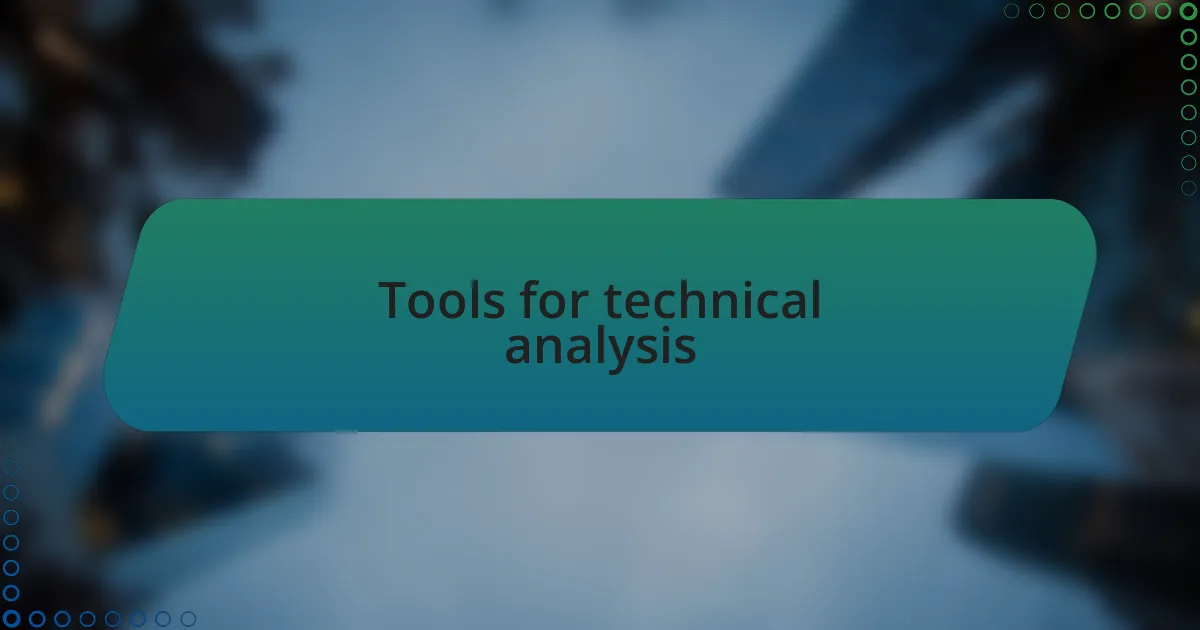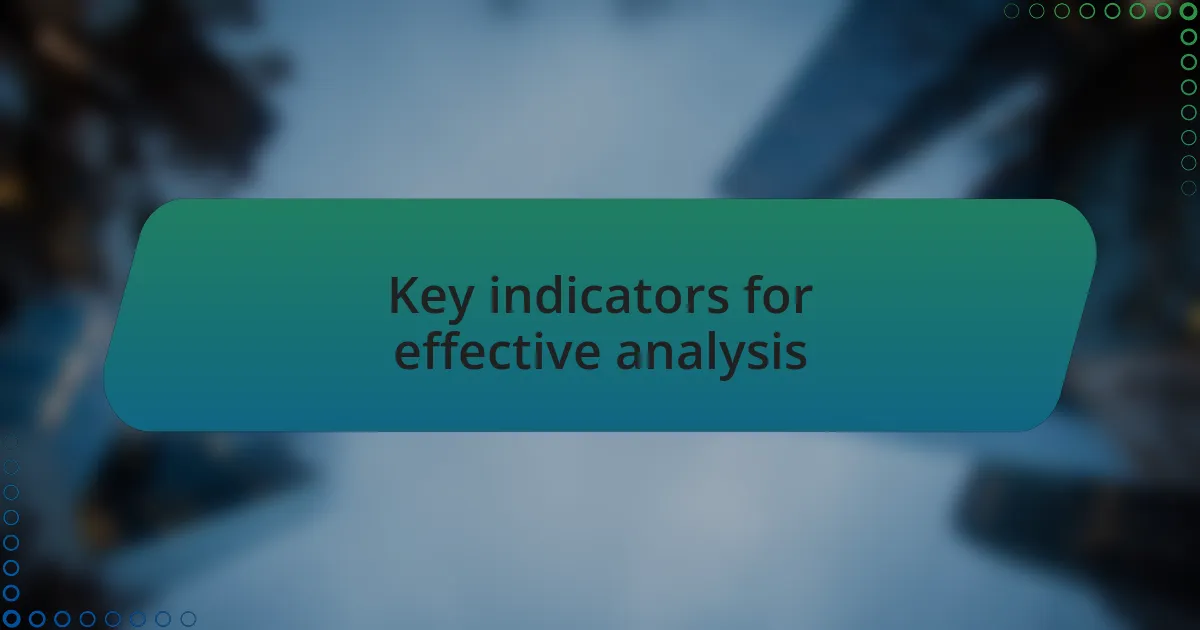Key takeaways:
- Understanding technical analysis involves interpreting charts and patterns to make informed trading decisions based on historical price movements.
- Key tools like charting software, Fibonacci retracement, and moving averages enhance the effectiveness of technical analysis.
- Combining multiple indicators, such as RSI and MACD, can lead to better market insights and successful trades.
- Emotional discipline and reflective journaling are crucial for improving trading strategies and learning from past experiences.

Understanding technical analysis
Understanding technical analysis is about dissecting charts and patterns to forecast future price movements based on historical data. I remember my first experience with a candlestick chart; it felt like learning a new language. Each candle had a story, and I was eager to decipher what it meant for my investments.
When I delve into different patterns, such as head and shoulders or double tops, I often reflect on how these shapes echo past behaviors of market participants. It fascinates me how traders’ psychology influences these formations. Have you ever considered that price movements aren’t just numbers but are driven by collective emotions?
I’ve found that using technical indicators like moving averages can clarify trends and signal when to enter or exit trades. I often ask myself, “Am I willing to let the data guide my decisions?” This mindset has transformed my trading approach, leading to more informed and strategic choices rather than emotional ones. Embracing technical analysis has been like gaining a new set of lenses to view the market.

Tools for technical analysis
When it comes to tools for technical analysis, one of my absolute favorites is charting software. These platforms allow me to customize my charts and add indicators that suit my trading style. I remember the first time I used a platform with real-time data—there was an adrenaline rush watching the market movements live. Have you ever felt that excitement when you spot a potential trade opportunity just seconds before everyone else?
Another essential tool in my arsenal is the Fibonacci retracement tool. At first, it seemed a bit complex, but over time, I came to appreciate how it helps identify key support and resistance levels. I often think about how those seemingly arbitrary lines can be powerful guides. Do you find it surprising that something grounded in mathematics can influence traders’ decisions so profoundly?
Lastly, I cannot overlook the power of moving averages. They smooth out price data to help me identify trends more clearly. I’ve had days when I relied heavily on moving averages to avoid whipsaws in my trading strategy, and they proved invaluable. Have you ever faced the challenge of second-guessing your trades? I certainly have, and this tool has often helped restore my confidence in the midst of market chaos.

Key indicators for effective analysis
Key indicators play a vital role in honing effective technical analysis. One of my go-to indicators is the Relative Strength Index (RSI). It measures the speed and change of price movements, which has often guided me in identifying whether an asset is overbought or oversold. I’ll never forget the moment I spotted an RSI divergence; it prompted me to take a position that led to a significant profit. Have you ever found yourself navigating a tricky market and wished for a little extra insight?
Another key indicator I frequently use is the Moving Average Convergence Divergence (MACD). It stands out for its ability to highlight potential trend reversals through the relationship between two moving averages. I distinctly recall a period of market volatility when MACD signaled an impending shift, enabling me to capitalize on a profitable entry point. It’s moments like these that reinforce the importance of combining different indicators to create a well-rounded analytical approach.
Lastly, I can’t underestimate the value of Bollinger Bands in my technical analysis toolkit. These bands adapt to market volatility and provide critical insights into price action. I remember one instance where the price approached the lower band, indicating a buying opportunity; I acted quickly and was rewarded as the price surged shortly after. It’s fascinating how a simple banding technique can illuminate potential market movements, don’t you think?

How I apply technical analysis
When I apply technical analysis, I often start by sketching out price charts and identifying key support and resistance levels. One of my memorable experiences was when I noticed the price bouncing off a strong support level after several attempts to break through. The excitement I felt at that moment—watching my analysis manifest in real-time—solidified my confidence in the predictive power of these levels. Have you ever experienced that rush when your predictions come to fruition?
In addition to price levels, I rely heavily on volume analysis to confirm my technical signals. I distinctly remember a situation where an increase in volume accompanied a breakout I was tracking. This validation was pivotal; it not only reinforced my decision to enter the trade but also heightened my sense of excitement about possible gains ahead. Isn’t it thrilling when the indicators align perfectly, suggesting a promising opportunity?
Combining these techniques creates a comprehensive picture that often leads to actionable insights. For instance, I recall a time when using a confluence of a bullish chart pattern with favorable RSI levels led me to invest confidently. The follow-through on that trade felt not just like a victory, but as if I had unlocked a deeper understanding of market behavior. Have you been waiting for that pivotal moment when everything just clicks into place?

Case studies of successful analysis
One case that stands out in my mind is when I used Fibonacci retracement levels to time an entry into a volatile tech stock. After noticing the stock retrace to a key 61.8% level, I felt a mix of anticipation and caution. As it turned around and began to rally, I was reminded of the importance of patience in the face of uncertainty—sometimes, the numbers lead you to the right moment, and this time they certainly did.
Another memorable instance involved a head and shoulders pattern I identified on a major currency pair chart. I had a gut feeling it was going to perform as predicted, but watching the confirmation unfold was exhilarating. Seeing the market shift precisely as I anticipated ignited a thrill that small victories often give; it reinforced my belief in honing my skills while embracing the beauty of the charts.
Reflecting on a recent trade with a simple moving average crossover, I was surprised by how powerful this seemingly straightforward analysis can be. The crossover pointed to a potential upward trend, and as I entered the trade, I felt a surge of excitement—like stepping into the rhythm of the market. Have you ever experienced that blend of exhilaration and trust in your strategy when a familiar pattern emerged? For me, it’s those moments that bring the joy of trading to life.

Lessons learned from my experiences
As I delved deeper into technical analysis, I learned the hard way that relying solely on one indicator can be misleading. I vividly remember a time when I chose to follow the RSI (Relative Strength Index) without considering the broader market context. The result? A frustrating loss that taught me the value of a multi-faceted approach. Have you ever focused too intently on a single piece of data, only to realize later that the bigger picture mattered more?
Another lesson that resonates with me is the importance of emotional discipline. I once found myself second-guessing a trade after reading conflicting news articles. In that moment, I felt torn between following my analysis and reacting to external noise. Ultimately, I held onto my position, and it paid off, reinforcing the idea that sticking to a well-researched plan often trumps impulse-driven decisions. How often do we let emotion dictate our investment choices, even when the charts say otherwise?
Lastly, I’ve learned that journaling my trades has been an invaluable practice. Reflecting on my decisions, both good and bad, has led to significant growth. One time, I reviewed a series of trades and discovered a pattern in my mistakes—namely, entering positions too early out of fear of missing out. This self-awareness has really helped me develop a more patient and strategic mindset, reminding me regularly that every experience, if analyzed, contributes to my journey in investment. Do you keep track of your trading journey, or do you find it easier to forget the hiccups rather than learn from them?